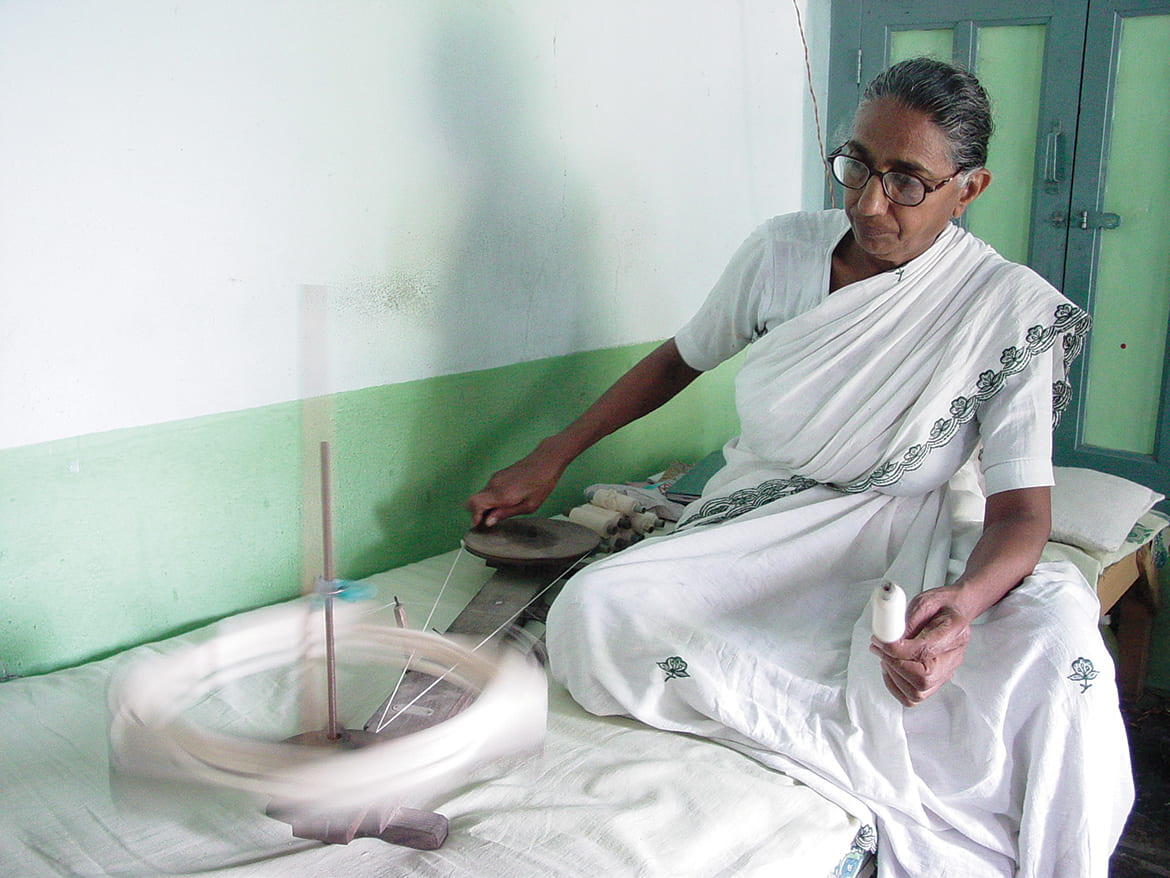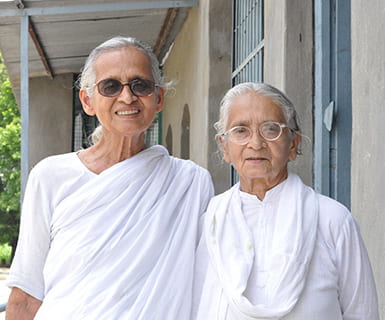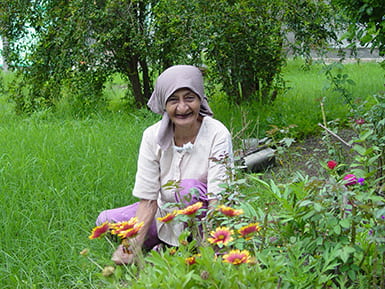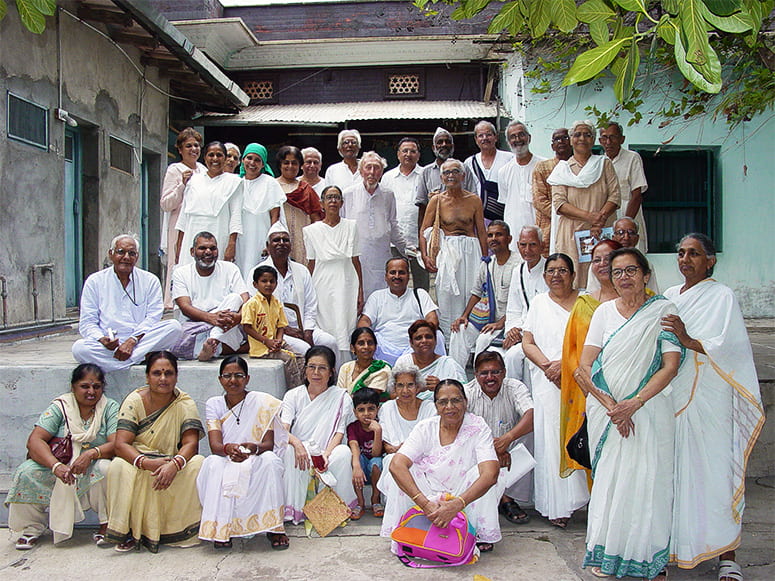
Featured
Simple Living & High Thinking
Ramu di. Courtesy Swasti Bhattacharyya
By Swasti Bhattacharyya
In rural central Maharashtra, India, on a hill overlooking the river Dham, sits the Brahma Vidya Mandir ashram. Since 1959, this place has been home to a community of independent, love-motivated women who are followers of Mohandas K. Gandhi (1869–1948) and his disciple, confidant, and spiritual successor, Vinoba Bhave (1895–1982). Wanting to pursue a spiritual path, these women challenged traditional societal expectations, approached Vinoba, and asked for his support. Believing in the full equality of women (and critical of the cultural limitations imposed on them), Vinoba gave the women his ashram and encouraged them to form a spiritual community.
My relationship with the older women in this ashram began in early childhood. For a couple of years before I entered first grade, my family and I lived in Gandhi’s Sevagram ashram, about five miles south of the Brahma Vidya Mandir. While I did not much care for the long walk on the dry, dusty road between the ashrams, I loved visiting my cousin, Veena di,1 and the other sisters who lived there. In my memory, the sisters greeted me with great delight. As a child I may not have understood their deep, engulfing love; however, I remember how special I felt every time we visited. Years later, early in my career as a professor and applied ethicist, my family and I returned to India for a visit. I was reacquainted with the sisters when we stayed with them for several weeks. As I interacted with them, I realized that, although they did not refer to themselves as environmentalists, feminists, or peace activists, their very lives embodied many of the commitments associated with these values. I appreciated the continuity between what they taught and how they lived, and I wanted to learn more from them. During the past 20 years, I returned regularly to live with the sisters in the ashram and to learn from them.
Usha di, a founding member of the ashram, talked about how their primary focus, as a community, is “samuhik sadhana.” Samuhik means “sitting together in a group,” and sadhana is a “sustained practice for spiritual attainment.” She further explained: “Sadhana is spiritual practice. It is about those who aspire for a spiritual life and who work accordingly. Sadhana means we are here for a spiritual life, so we try to practice a spiritual life. One who tries to practice a spiritual life is a sadhak [seeker of spiritual things]. Here it is spiritual community living, not community living.”
I asked Usha di what she meant by “spiritual.” Her response: “My simple definition of a spiritual life is simple living and high thinking. Unless you have simple living, you won’t have high thinking. High thinking means in life, not in only words. This is the simplest definition of spirituality.” This phrase, “simple living and high thinking,” captures the essence of life for Usha di and the other sisters living in this community. For these women, there is ultimately no separation between their thinking and living: the seamlessness between their thoughts and actions is their spirituality.

Ganga ma and Usha di. Courtesy Swasti Bhattacharyya
The sisters’ high thinking is grounded in such Gandhian principles as ahimsa (nonviolence, no harm), satyagraha (holding fast to truth) and Sarvodaya (holistic uplifting of all humanity, all life). While many know about Gandhi’s reliance on truth and his use of nonviolence in his work to free India from British rule, not as many are familiar with his development of the philosophy of Sarvodaya. Gandhi coined this term, and Vinoba built it into an influential grassroots movement, where people throughout India worked for the betterment of all. A potent example of Sarvodaya is the Bhoodan (land gift) movement that Vinoba launched in 1951. While attending a community gathering in a village southeast of Hyderabad, Vinoba was approached by a group of landless families. They asked him to take their petition for land to the governmental authorities. He agreed to do so. However, while he understood that doing this might help this particular group of people, it in no way addressed the vast issues of poverty in India. As he was reflecting upon this dilemma, a local wealthy landowner stood up and offered the families 100 acres. Inspired by this act of generosity, Vinoba began the Bhoodan Yagna. For 14 years, he and thousands of others walked from village to village, inviting those who had land to give it to those who had none. Many of the original members of the ashram walked with Vinoba on the Bhoodan. Once the women came together to form this ashram, they continued the work of Sarvodaya, albeit in a different way.
The sisters’ aim of a spiritual life, as a community of women (samuhik sadhana), is not just for their own benefit. Their form of spirituality, their simple living and high thinking, is practiced within the larger context of working for a world in which everyone can flourish (Sarvodaya). Their commitment to Sarvodaya, ahimsa, and satyagraha dovetails with the Advaita Vedanta worldview shared by most of them: a worldview where Brahman (ultimate reality) permeates everything. As expressed in the Chandogya Upanishad: “In the Beginning there was Existence, One only, without a second. . . . He [Brahman], the One, thought to himself: Let me be many, let me grow forth. Thus, out of himself he projected the universe; and having projected out of himself the universe, he entered into every being.” Shankara, the famous eighth-century Advaita Vedanta philosopher, writes: “the Supreme Brahman, which is eternal, stainless, and free; which is One, indivisible and nondual; and which is of the nature of Bliss, Truth, Knowledge, and Infinity.”2 This understanding of an underlying unity to all life is the basis for the sisters’ idea of spirituality, their commitments to satyagraha, ahimsa, and Sarvodaya, as well as the five foundational principles upon which their community is grounded: shrama (manual labor), swadhyaya (self-study), brahmacharya (chastity/control of the passions), bhakti (devotion), and samuhik sadhana.
This high thinking and simple living is evident throughout the daily life of the sisters. Because of their commitment not to be a burden on society, and to be as self-reliant and self-sustaining as possible, they grow 70 to 80 percent of their food and maintain a dairy with about a dozen cows. They live as close to the earth as possible and have a relatively small carbon footprint. They live in solidarity with the poor, and they pray for the peace of the world. Their simple living and high thinking is also evident in their choice of clothing: they make and exclusively wear khadi—clothes made from handspun, handwoven cloth.

Veena di. Courtesy Swasti Bhattacharyya
To make cotton khadi, the sisters begin with cotton grown by village farmers and processed locally into punis (thin rolls of fibers). With different types of charkhas (spinning wheels), they spin the cotton punis into thread. In the early days, they used to weave their own cloth; now, however, they take their skeins of handspun thread to a nearby ashram, where it is woven into cloth. Once the sisters have the khadi cloth, they sew their own clothing. Each year, a sister spins enough cotton to make at least one new outfit. The making and wearing of khadi simultaneously supports both a simple, environmentally sustainable lifestyle and, in multiple ways, their high thinking.
First, spinning is an integrated part of their prayer life. The sisters spin in the morning before breakfast, during the 10:30 AM communal prayer, as they chant the Vishnu Sahasranamam (a prayer with the thousand names of Vishnu), during communal meetings, and throughout the day.
For many, spinning is prayer and meditation. The actual act of spinning the cotton thread is meditative and requires mindfulness. There is a rhythmic, synchronized dance between the cotton, held in one hand, and the wooden knob used to turn the wheels of the charkha held in the other. It is a dance where the speed at which a sister pulls the cotton puni needs to be in sync with the amount of twist in the fibers from the turning wheels of the charkha. When correctly done, the right amount of cotton fiber is twisted together to form strong, uniform thread. It takes a lot of patience and concentration at the beginning. Spin too slowly, the thread will get too thick; it will not have enough twist in the fibers and may even lock up. Spin too fast, or pull the puni too fast, and the thread will be too thin and may break. With practice and mindfulness, each sister becomes increasingly proficient. There is a particular, satisfying whirling hum when the speed at which she turns the wheels of the charkha matches her strokes as she pulls the fibers from the puni, such that the tension in the thread being created is just right. It is meditative and can invoke an “in the zone” feeling. Spinning is a productive way to practice mind-body mindfulness. For the sisters, it is both a tool for enhancing their meditative experience and a way in which they clothe themselves. Just as they twist the cotton fibers into a single strong strand, they are binding together multiple aspects of their lives. The very process of making their clothing is their spirituality.
Second, by spinning their own khadi, the sisters are living out their commitment of nonmaterialism—an important element for simple living. Besides keeping their personal belongings to a minimum, the time and labor required for making khadi has an outcome where each sister owns only a couple of outfits. As Usha di explains the reasons for their focus on nonmaterialism, she recounts part of a devotional song of Tukaram (a Maharashtrian saint). After having a direct experience with God, Tukaram went from home to home trying to share his experience with others. However, the people were not interested. After he is repeatedly rebuffed, he ends his song with a lament, “You have so much luggage in your house, then where will you put God?” Usha di concludes her story by saying: “That is the position today. People love more furniture, not more God, so if we keep our house free, we will feel more freedom.” By making and wearing only khadi, the sisters possess less clothing, thereby upholding their ideal of nonmaterialism. In doing this, their rooms, and their minds, are not full of clutter. Consequently, according to Usha di, their choice of clothing allows for them to have more freedom and more room for God.

Gita ji. Courtesy Swasti Bhattacharyya
Third, having invested time and energy into creating their own clothing, the sisters value the cloth itself and are mindful of how they utilize it. A sister’s newest, spotless garment is reserved for when she goes outside of the ashram or is receiving visitors. The outfit she wears every day might have a stain and a patch or two, but it is still presentable. An even older, more tattered garment is worn when gardening or working on messy jobs. Once a garment is beyond salvage, it is repurposed as a mop or cleaning rag. Only when the cloth has deteriorated to a useless mesh of biodegradable fibers, does she throw it away. This attitude toward their clothing has profound implications when it comes to the use of natural resources and contributions to pollution. Usha di explicitly says: “More need, more furniture, more luggage—that means you are contributing to pollution, so this simple way of living is just to save the problem of the age. Pollution is the problem of this age.” Beyond having fewer possessions, the sisters’ use of khadi addresses other issues related to pollution. Their clothing is free of petroleum-based materials, and their garments are free from all the pollution involved in the global market of mass-produced clothing.
Fourth, khadi also exemplifies the sisters’ commitment to nonviolence and Sarvodaya—the holistic uplifting of all humanity and the earth. Khadi is nonviolence in action. As I described above, by using khadi, the sisters are mindful of their use of natural resources and of keeping their pollution to a minimum. There is another way khadi is nonviolent and uplifts all of humanity. Usha di explains how, by making and wearing khadi, they are circumventing the entire market economy that oppresses and suppresses the most vulnerable people on the earth. She says:
In the [Bhagavad] Gita, it is said that one who does manual labor, his life is innocent because he is not exploiting anybody. Otherwise, when I live on the market and when I go to the market to purchase this cloth, if it is not khadi cloth, if it is another cloth, then that mill owner, he is exploiting the labor, and we are part of that labor exploitation. So, when we do manual labor, we have less exploitation in our life because we earn by our own.
Having made their own khadi, the sisters know the origin of their clothing, and they know that no one was exploited in the process of making it.

Sarvodaya workers wearing khadi. Courtesy Swasti Bhattacharyya
Finally, khadi is a symbol of the sisters’ deep belief in the true equality of all humanity. Each sister, as she is able, spins; khadi is a product of their manual labor. Regardless of each sister’s background—she may have been a professor of Sanskrit literature or an illiterate worker—their labor, be it manual or intellectual, is equal, and valued equally. This is particularly significant in a societal context where the wealthy, the educated, or professionals often hire others to perform required daily tasks. Usha di states: “We try here to live life on manual labor. Outside, the educated people don’t have value for manual work, and they should establish this value. Otherwise, there will be two divisions—one intellectual and the other hardworking. We should combine them.” By spinning their own khadi, the sisters circumvent an entire global system that devalues and oppresses the poorest among us. Through their use of khadi, the sisters demonstrate a way of working for Sarvodaya, a world in which everyone may flourish.
Every time I reflect upon the sisters of the Brahma Vidya Mandir ashram and Usha di’s “simple living and high thinking” phrase, I am challenged and inspired. I spin cotton: it is a very mindful, meditative practice. However, if I wanted to clothe myself, it is not a practical option. Instead, I have downsized my wardrobe, become more mindful of where I purchase my clothing, and, like the sisters, I take care of the clothing I own. In the end, I am not advocating that everyone spin and wear their own khadi. Nevertheless, there is plenty for us to consider when thinking about how we want to live. Imagine the implications if we were:
- to practice meditation and mindfulness: to simply be more aware of how we live
- to commit to nonmaterialism
- to value natural resources and our use of them
- to work to decrease the pollution we generate
- to value nonviolence
- to truly believe in the equality of all humanity.
I do not argue that we should simply copy the way the sisters live. However, if we contemplate some of the important implications of the sisters’ actions and thoughts, and consider applying them to our own lives, perhaps we will have threads of hope that we can utilize as we work for a sustainable future.
I hope the sisters are an inspiration for us to move forward in working for a more sustainable, compassionate, and loving world.
Swasti Bhattacharyya, Professor Emeritus of Philosophy and Religion at Buena Vista University, has been Visiting Professor Emerita of Women’s Studies and Ethics and a Women’s Studies in Religion Program Research Associate at HDS during 2021–22. Her book, Magical Progeny, Modern Technology (State University of New York Press, 2006), combines her experiences as a registered nurse with her expertise in ethics and the study of religion.
Please follow our Commentary Guidelines when engaging in discussion on this site.

